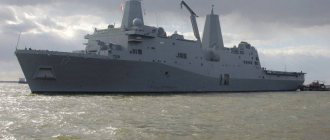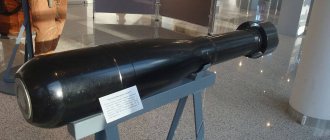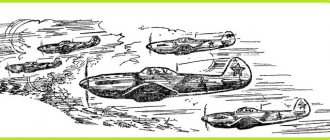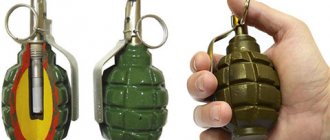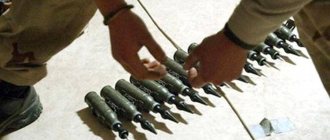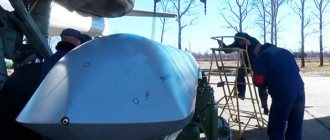Making a sea mine
A sea mine is a munition that is placed covertly in the water. It is intended for damaging enemy water transport or impeding its movement. Such military products are actively used in offensive and defensive operations. After installation, they remain in combat readiness for a long period, but the explosion occurs suddenly, and it is quite difficult to neutralize them. A sea mine is a charge of explosive materials contained in a waterproof casing. There are also special devices inside the structure that allow you to safely handle ammunition and explode it if necessary.
Torpedoes and Mines
Varieties
Torpedo - self-propelled sea mine
sea mine
"Zircon" and "Skif" - bottom weapons of the Russian Navy
Multiple launch rocket system on a ship
Images
History of creation
The earliest mentions of sea mines are recorded in the records of the Ming officer Jiao Yu in the 14th century. In the history of China, similar use of explosives is mentioned in the 16th century, when there were clashes with Japanese robbers. The ammunition fit into a wooden container, protected from moisture with putty. Several mines drifting in the sea with a planned explosion were planted by General Qi Jugang. Subsequently, the mechanism for activating the explosive was activated using a long cord.
A project on the use of marine worlds was developed by Rubbards and presented to Queen Elizabeth of England. In Holland, the creation of weapons called “floating firecrackers” also took place. In practice, such weapons turned out to be unsuitable for use.
A full-fledged sea mine was invented by the American Bushnell. It was used against Britain in the War of Independence. The ammunition was a sealed barrel of gunpowder. The mine drifted towards the enemy, exploding upon contact with the ship.
The electronic mine fuse was developed in 1812. This innovation was created by the Russian engineer Schilling. Jacobi later discovered an anchor mine capable of floating. The latter, in an amount of more than one and a half thousand pieces, were placed in the Gulf of Finland by the Russian military during the Crimean War.
According to official statistics of the Russian naval forces, the first successful case of using a sea mine was considered to be 1855. Ammunition was actively used during the Crimean and Russian-Japanese military events. During the First World War, with their help, about four hundred ships were sunk, of which nine were battleships.
Anchor mine
The most widespread in the Far Eastern theater of operations was the sea mine with an anchor lock. It was kept submerged by a mine rope attached to an anchor. The immersion depth was initially adjusted manually.
In the same year, Lieutenant of the Russian Navy Nikolai Azarov, on the instructions of Admiral S. O. Makarov, developed a design for automatically immersing a sea mine to a given depth. I attached a winch with a stopper to the ammunition. When the heavy anchor reached the bottom, the tension of the cable (minrep) weakened and the stopper on the winch was activated.
The Far Eastern experience of mine warfare was adopted by European states and widely used during the First World War. Germany has achieved the greatest success in this matter. German sea mines closed the Russian Imperial Fleet in the Gulf of Finland. Breaking this blockade cost the Baltic Fleet heavy losses. But the sailors of the Entente, especially Great Britain, constantly set mine ambushes, closing the exits of German ships from the North Sea.
Types of sea mines
Sea mines can be classified according to several different parameters.
Based on the type of installation of ammunition, they are distinguished:
- The anchors are attached at the required height using a special mechanism;
- The benthic ones sink to the seabed;
- Floaters drift along the surface;
- Pop-up ones are held by an anchor, but when turned on they rise vertically out of the water;
- Homing or electric torpedoes are held in place by an anchor or lying on the bottom.
According to the method of explosion they are divided into:
- Contact ones are activated upon contact with the body;
- Galvanic impact react to pressing on the protruding cap where the electrolyte is located;
- Antennas explode when colliding with a special cable antenna;
- Non-contact ones operate when a vessel approaches a certain distance;
- Magnetic ones respond to the ship's magnetic field;
- Acoustic ones interact with the acoustic field;
- Hydrodynamic ones explode when the pressure changes due to the ship's progress;
- Induction ones are activated by fluctuations in the magnetic field, that is, they explode exclusively under moving galleons;
- Combined ones combine different types.
Also, sea mines can be differentiated in terms of multiplicity, controllability, selectivity and type of charge. Ammunition is constantly improving in power. Newer types of proximity fuses are being created.
Aviation bottom induction-hydrodynamic mine IGDM-500
Carriers
Sea mines are delivered to the site by surface ships or submarines. In some cases, ammunition is dropped into the water by aircraft. Sometimes they are located from the shore when it is necessary to carry out an explosion at a shallow depth to counteract landings.
Naval mines during World War II
In certain years, among naval forces, mines were “weapons of the weak” and were not popular. Major naval powers such as England, Japan and the USA did not pay much attention to this type of weapon. During the First World War, attitudes towards weapons changed dramatically, when it was estimated that approximately 310,000 mines were delivered.
During the Second World War, naval “explosives” became widely used. Nazi Germany actively used mines; about 20 thousand units were delivered to the Gulf of Finland alone.
During the war, weapons were constantly improved. Everyone tried to increase his effectiveness in battle. It was then that magnetic, acoustic and combined sea mines were born. The use of this type of weapon not only from water, but also from aviation expanded their potential. Ports, military naval bases, navigable rivers and other water bodies were under threat.
There was heavy damage in all directions from sea mines. Approximately a tenth of transport units were destroyed using this type of weapon.
About 1,120 mines were installed in the neutral parts of the Baltic Sea at the start of hostilities. And the characteristic features of the region only contributed to the effective use of ammunition.
One of the most famous German mines was the Luftwaffe Mine B, which was transported to its destination by air. LMB was the most popular of all sea-bottom proximity mines assembled in Germany. Its success became so significant that it was also adopted for installation on ships. The mine was called Horned Death or Magnetic Death.
Hunting for Gauss
German bottom proximity sea mines throughout the Second World War remained one of the most dangerous opponents for the Allied and Soviet fleets, causing them very painful losses in ships and personnel. These mines also posed a mortal threat to merchant shipping, being an extremely effective means of destroying ships and blocking sea communications. The best German engineers and scientists worked tirelessly to implement increasingly advanced systems for detecting and destroying sea targets, using all the physical effects known to science that are created by a ship in the aquatic environment. The first milestone in this ruthless race of brains and technology was a mine with a magnetic fuse.
New generation mine
The first bottom magnetic mines were created by the British at the end of the First World War - they first used the new weapon against the Germans off the Belgian coast in August 1918, and in the summer of 1919 they used them against Soviet shipping on the Northern Dvina. These mines with a concrete body, a charge of 360 kg of TNT and a fuse in the form of a simple magnetic contactor turned out to be very effective, but extremely unreliable and dangerous for the minelayer himself.
Detonation of a German LMB mine in the Thames Estuary in September 2022. The power of detonation of 900 kg of explosives at shallow depths is clearly visible. Almost all German bottom mines were designed to be placed at depths of up to 35 meters, optimal for the greatest explosion effect
The effect of a proximity mine explosion differs from the consequences of a conventional contact mine explosion, which destroys the ship's hull, after which the shock wave is discharged in compartments filled with easily compressible air. The explosion energy of a bottom mine is distributed in the following ratio: 53% - shock wave, 46% - thermal energy, 1% - light radiation. A shock wave in an incompressible mass of water is the first direct damaging factor, crushing the hull of a ship and disabling internal equipment. The release of thermal energy leads to the formation of a gas bubble after the explosion, which expands until it begins to collapse under environmental pressure, repeating the process in a split second until the energy is completely lost. This effect was especially dangerous if the mine exploded at the bottom directly under the ship, which, in fact, found itself in a zone of cavitation of monstrous force. The resulting effect of this “gas-water hammer” on the ship’s hull was usually disastrous - the ship either broke or suffered severe structural damage.
Soviet miners managed to successfully disarm British mines, develop a method of combating them and a special trawl. However, this experience very quickly turned out to be unclaimed and forgotten, like British developments in the field of magnetic mines. They took the magnetic mine extremely seriously and launched extensive research in this area in a completely different country - Germany, a loser and thirsty for revenge.
Already in 1923, the mine department of the Reichsmarine Mine Test Center (Sperrversuchskommando - SVK) undertook the first research and development in the field of bottom proximity mines and magnetic fuse. If there were no particular problems with the design of the hull-mechanical part of the first RM-type bottom mines, intended for deployment from surface ships, the most important element - the non-contact magnetic fuse - was not immediately successful.
German engineers, as often happened, went their own original way. Taking into account the development of electrical engineering, the most obvious way to create a promising magnetic fuse was to use an induction coil - it was precisely such mines with induction-type rod fuses that were subsequently created by Western and Soviet specialists. The induction fuse responded to changes in the horizontal component of the Earth's magnetic field, that is, close movement of metal masses. However, in Germany they decided to create a pointer-type fuse, which was based on an inclinometer device, invented by German scientists in 1909 to help crews of balloons and airships determine their location in poor visibility conditions. The principle of operation of the inclinometer was to determine the angle of deflection of the needle relative to the zero magnetic meridian and further orientation along known isodynamics - lines with the same strength of the Earth's magnetic field.
British sailors from a barge laying mines on the Northern Dvina, 1919
This technical solution made it possible, firstly, to significantly reduce the cost of the fuse design, since the production of induction coils required a large amount of scarce copper and nickel, and secondly, to simplify the layout of the mine and have ample opportunities for various upgrades. Most importantly, such a fuse responded to changes in the vertical component of the magnetic field - that is, it recorded the moment when the ship or vessel was almost above the mine. It was this factor that played a big role in the successes of the Germans in the coming mine war.
In 1925, a magnetic fuse, which received the name E-BIK (Ballon-Inklinometer - balloon inclinometer), was ready and tested, but did not yet meet strict combat reliability standards. After several years of hard work, in which the best German companies specializing in the production of high-precision measuring equipment took part, in 1928 a reliable fuse with preliminary manual adjustment of the magnetic field was created, completely suitable for combat use.
One of the first BIK type fuzes produced in 1929
Having received a working fuse, SVK specialists began active work on the final formation of their “mine triad” - the development of magnetic mines for use not only from surface ships, but also from submarines and aircraft, although these types of weapons were prohibited by the Treaty of Versailles.
By 1934, work on the creation of magnetic “torpedo mines” TM, intended for deployment from submarines, and aircraft mines of the LM series, unified with the calibers of torpedoes and aerial bombs, was basically completed. It remained to develop parachute systems for aircraft mines, the creation of which was energetically joined by specialists from the newly created Luftwaffe.
The joint efforts of the navy and air force were crowned with success: four years later, the LMA and LMB aircraft mines were accepted into service, and the full line of combat-ready types of magnetic mines of the Third Reich became a reality. A common distinguishing feature of all these mines was a fragile aluminum alloy body, which in the case of aircraft mines, which experience the most severe loads during deployment, had far-reaching consequences.
Diagram of the British anchor magnetic mine Mk.I. The induction coil running through the entire body is clearly visible. The German fuse was much more compact
Nevertheless, it was on aircraft mines that the Kriegsmarine leaders placed their main hopes, since they understood that the very weak German fleet would not be able to carry out regular deployments in hostile waters. Based on these considerations, during the Sudetenland Crisis of 1938, the production of LM mines was given top priority by temporarily stopping the production of submarine mines. This happened, however, in an emergency manner, indicating that a mismatch was beginning between the fleet and the air force in matters of planning combat operations at sea. Since 1936, the production and accumulation of LM mines became the prerogative of the Reich Ministry of Aviation, and, as the former head of the mine inspection, Rear Admiral Witold Rother, accidentally found out, nothing was done in this direction. The head of the technical department of the ministry, Lieutenant General Ernst Udet, had to admit the omission and take measures to establish mine production.
In parallel with the introduction of bottom mines into service, the Germans were actively working on creating anchor mines with a magnetic fuse, although this turned out to be a much more difficult task. The E-BIK magnetic fuse was significantly improved: in 1938, it implemented automatic magnetic field adjustment, and the official name was changed to SEBIK (Selbsteinstellendes - “self-adjusting”). By 1939, the fuse was produced in several modifications, which were subsequently classified with the index “M” (M1, M2, M3) and differing in the way they set the value and compensate for external factors. The M3 fuse was bipolar - reacting to magnetic fields of both northern and southern directions.
Damage to the bottom and keel of the cruiser Belfast, which on November 21, 1939 became the first Royal Navy cruiser to hit a magnetic mine. The monstrous force of the impact is clearly visible - in the absence of holes, the cruiser spent two long years undergoing major repairs. The explosion of a bottom mine caused terrible damage to internal equipment and mechanisms
It cannot be said that the magnetic mine was a unique German know-how at the beginning of World War II: mines with induction fuses were adopted in the USA, Great Britain and the USSR. However, it was the Germans who had the greatest experience, created a specific fuse, a unified “triad” and were ready for the widespread use and production of these ammunition, and a huge technological and scientific reserve allowed them to constantly be one step ahead of their opponents.
Magnetic attack on England
Kriegsmarine admirals in their post-war memoirs repeatedly complained that at the beginning of the war, the naval forces of the Third Reich, in terms of their combat and numerical strength, were absolutely not up to the task of confronting the combined fleets of Great Britain and France. The situation with the presence of mines was the same: according to very optimistic pre-war plans, only by the spring of 1940 several tens of thousands of these ammunition should have accumulated, ready for operational use. However, as of September 1939, there were only about 600 aircraft mines of the LMA and LMB types, and several hundred ship-based RM and submarine TM mines in warehouses.
Recovering the wreckage of the destroyer Gypsy, which was blown up by magnetic mines laid by German destroyers in the Thames Estuary, October 21, 1939. Many ships lost to mines became a serious navigational hazard for others
Before the outbreak of hostilities, the Naval War Command Headquarters (Seekriegsleitung - SKL) experienced some hesitation about whether, with small stocks of magnetic mines, it was worth immediately starting to use them against the British. However, the doubts turned out to be unnecessary: it turned out that the stock of mines and the rate of their production were quite consistent with the number of minelayers, the increase in the number of which was a very vague prospect.
Having chosen the strategy of an “economic siege” of Great Britain, the Germans decided to strike at key points on the east coast of England, the ports of which received an intense flow of strategic raw materials - Scandinavian ore and timber.
The first deployments of TMB mines by Type II small submarines were successful and gave the green light to plans for an extensive mine blockade of Great Britain. Agent reports and radio interceptions indicated that the British were suffering losses, closing the fairways and did not have effective measures to counter the new weapons. However, 60 mines laid by boats in September did not wake up the “English lion” - real thunder struck when, with the onset of long nights in mid-October, German destroyers went out to lay mines, which immediately laid 180 magnetic mines of the RMA and RMB types.
The steamship "Magdapur" (SS Magdapur) was the first victim of magnetic mines, dying on September 10, 1939 at a barrier set up by the German submarine U 13. In total, from September 1939 to March 1940. mines killed 129 Allied and neutral merchant ships with a total tonnage of 430,000 GRT
From October 17 to November 17, having deployed 538 magnetic mines during three operations, German destroyers blocked the approaches to the Thames and the Humber, and the situation for London immediately became critical. The head of the Admiralty, Sir Winston Churchill, urgently formed a special group of the best naval specialists to fight the German “miracle weapon,” which he immediately transferred to barracks. This unit, which would soon become the secret Department of Torpedoes and Mines Investigation Section (DTMI), was headed by Rear Admiral Frederick Wake-Walker.
Reserve Lieutenant Ashe Lincoln, a miner who worked as a lawyer before the war, was appointed as an analyst for the group. He was literally pulled out of the minelayer at night, because the admiral decided that a meticulous lawyer was needed for such work. According to Lincoln's recollections, Wake-Walker allowed everyone present to sit down and began his speech with the words: “Well, boys, the country is in terrible danger.”
The admiral briefly outlined the state of affairs to the stunned officers: most of the harbors and river mouths were blocked by mines of an unknown type and ordinary contact mines. All trawling attempts were unsuccessful: only in Bristol Bay were they able to detonate one, apparently magnetic mine. Attempts to locate and capture the mine for examination were unsuccessful. On the Downs alone, 185 ships are blocked and cannot enter the Thames, and 70 ships cannot leave London docks. About six ships per day are lost or damaged. If the situation is not corrected, Britain will fall in six weeks!
A German bottom mine of the RMA type with a charge of 800 kg of explosives, intended for deployment from surface ships. The hemispherical shape was not chosen by chance: it was this that ensured the correct immersion and position of the mine at the bottom. Subsequent modifications of this mine were made in a concrete or wooden cubic case - the war required economy
After the distribution of tasks and responsibilities, Churchill himself met with the group’s personnel, who took the activities of the DTMI under personal control. The First Lord was gloomy - some neutral governments had already recommended their shipowners to refuse voyages to England, and the press was spreading the wildest rumors. For now, Churchill and Prime Minister Neville Chamberlain could only make threatening statements on the radio that “the German mines will be defeated in the same way as we defeated their submarines in the Great War.”
. In Berlin, such speeches were received with satisfaction - the Germans rightly perceived such statements as a sign of the enemy’s inability to turn the tide.
The battle with Gauss begins
The British weren't even entirely sure that German mines had a magnetic fuse. The only confirmation was the same explosion in Bristol Bay, when two trawlers dragged along the bottom a cable attached between them, on which several powerful bar magnets were attached, and blew up something that could have been a mine. However, such a trawl was unacceptable: it constantly got tangled, clung to underwater obstacles and broke off, for which it received the nickname “the boatswain’s nightmare.”
German technicians load LMB aircraft mines
But the Wake-Walker group was lucky: two days after its formation, the Germans began air raids at the mouth of the Thames. The Luftwaffe command was very wary of the fleet’s proposal to urgently begin mining the coast of England from the air, since the Wehrmacht High Command (Oberkommando der Wehrmacht - OKW) ordered to be prepared for a massive barrage of Belgian ports in the event of the outbreak of active hostilities on the Western Front, and the release of aircraft min has not yet exceeded 120 pieces per month. Goering’s department proposed to begin aerial productions in the spring of 1940, when a decent supply of mines would be accumulated. However, the sailors were extremely persistent, the Fuhrer also loudly declared that it was aircraft mining that would bring Great Britain to its knees, and Major General Joachim Coeler, commander of the air units subordinate to the naval group West, was ordered to act.
The production began on November 20, and already on the night of November 22, one of the Heinkel He-59 seaplanes dropped two LMA mines on a sandbank near the town of Shoeburyness in the Thames Estuary. Pre-war fears were justified: despite the parachute release system, the aluminum case did not prevent the fragile equipment from damage during a hard impact; the hydrostatic device collapsed and was unable to activate the mine’s self-destruction system. Looking ahead, we can say that this will become the Achilles heel of the LM type mines: on July 5, 1941, under the same circumstances, the first German aircraft was disarmed in the Soviet Black Sea Fleet.
Mine and torpedo center HMS Vernon, the main entrance and the territory of the complex from a bird's eye view. It was the oldest (since 1876) center of the Royal Navy for the study of torpedo and mine weapons. In August 1940, a German mine exploded on its territory while defusing it, killing five miners. The Germans knew about his role and took brutal revenge by bombing the center in the fall of 1941, killing more than 100 people. "Vernon" was disbanded on April 1, 1996, its administrative building now houses the "Old Customs House" beer pub.
Urgently arrived specialists from the Vernon (HMS Vernon - a ground-based research center for mine and torpedo weapons of the Royal Fleet, known as the "stone frigate") Lieutenant Commander John Ouvry and Petty Officer Charles Baldwin managed to defuse both mines, after which the principle of operation of the fuse was studied and brainstorming immediately unfolded in two directions: demagnetization of ships and the creation of an effective trawl. There was a certain clarity with the first question; the principle of winding demagnetization was already known - several cable windings are permanently installed on the ship and a magnetic field is created in them, compensating the magnetic field of the ship. This was very expensive, and yet the industry was ordered to produce at least 1,500 km of cable per week until another solution to the problem was found.
Since the unit of measurement of magnetic induction is called “Gauss” in honor of the famous German scientist Carl Gauss, with the light hand of one of the officers, the work on countering German magnetic mines received the playful nickname “Wild Hunt for Gauss” among specialists. While round-the-clock work was in full swing in the “stone frigate,” when clearing the fairways we had to make do with a very expensive and disposable ersatz, which was called a “sleigh.” It was a barge with a simple powerful electromagnet, which was towed by a trawler. When they exploded, the “sleds” were killed, which cost the British £3,000, but there was no other way out yet.
In the foreground is "Borde" - Churchill's "miracle breakthrough". Life on this ship was hell: in addition to constant nearby explosions, all metal objects on board were strongly magnetized, watches and instruments failed, and no one thought at all about how a huge electromagnet affected people’s health
Certain hopes were placed on “breakthroughs” like the ship HMS Borde, in the bow of which there was a powerful electromagnet weighing 400 tons. The British created this system back in early 1939, but it was designed against induction-type mines, which were being prepared for adoption by the Royal Navy. The problem was that induction mines reacted to changes in the horizontal component of the magnetic field, and the German fuse responded to changes in the vertical component. As a result, the mines were detonated too close to the “breacher” and caused significant damage, not to mention the sensations of the crew members.
Churchill was nevertheless delighted, calling Bordet the most valuable ship in the fleet. And yet, scientists and engineers worked feverishly to invent an absolutely effective, safe and widespread method of trawling magnetic mines. One theoretical proposal from Royal Naval College Greenwich professor Bernard Haigh attracted the attention of 35-year-old physics and chemistry scientist Lieutenant Commander Charles Frederick Goodeve, who figured out how to put the idea into practice. .
Canadian-born scientist and Royal Navy Reserve officer Sir Charles Goodeve (1904–1980) became a veritable evil genius in the Kriegsmarine and Luftwaffe. In addition to inventing the electromagnetic trawl and “degaussing,” he managed to launch licensed production of 20-mm Oerlikon anti-aircraft guns in the UK, and subsequently took an active part in the development of the Hedgehog anti-submarine bomb launcher. His reward was very modest - after the war, Goodeve received a bonus of 7,500 pounds sterling
On a frosty December day in 1939, residents of Portsmouth observed an unusual picture: in a small lake formed by sea tides, where their children swam canoes and tested model ships, work was in full swing. The sailors cleared the water surface of ice, and two cables were laid to the bottom of the lake along the opposite shores. The surrounding residents were informed that a new secret device was being tested to detect enemy ships and were asked to launch their models and canoes. In the very midst of this “fleet”, in the boat there was a sailor who was holding in his hands a box with a fuse from a mine found in Shoburyness, connected to power and measuring instruments. Charles Goodeve was the only one among the sailors present and even those carrying out his orders who knew what was happening. He waited tensely for everything to be ready to test the device he had invented. The command to supply current was received, and suddenly the German fuse literally flickered, its needle darting across all scale divisions.
Thus was created the famous "double L" or "LL" trawl, which broke the dominance of German magnetic mines in English waters. Returning after the tests to his office in the “stone frigate”, the happy lieutenant commander discovered a letter from Whitehall marked “Top Secret”, where he was told what was already a banal thing in the fate of all true discoverers: “You must stop any research on the specified in Your latest directions report. It is absolutely clear that the method you propose is extremely dangerous and unsuitable for use.”
British sailors work with the LL type trawl. Two minesweepers, running parallel about 200 meters from each other, each released two branches of a floating cable (long and short) with copper electrodes at the end. When a pulsed current was supplied to the cables, a magnetic field was formed between them, detonating mines with a magnetic fuse on a section of the bottom with an area of 0.4 km²
On December 26, 1939, full tests at sea confirmed the effectiveness of the new trawl. In Britain, the traditional Boxing Day was celebrated on this Christmas day, and the entire British people really received an incredible gift that they had never even suspected. On January 18, 1940, the industry produced the first special cable for trawls, combat trawling began in February, and by the end of March 74 magnetic mines were destroyed.
Goodeve also solved the problem with winding-free demagnetization of ships. He developed a procedure for stationary winding-free demagnetization of ships, which he symbolically called “degaussing.” Its essence was that ships that did not have their own demagnetization equipment were subjected to temporary “erasure” of the magnetic signature at specially equipped stations. In April 1940, 10 “degaussing” stations were already functioning, through which about 1000 ships and vessels passed by June - most of them took part in the Norwegian campaign and the evacuation from Dunkirk.
Transportation of LMB(S) mines: the plugs in place of the parachute compartment are clearly visible
But, in Churchill’s famous words, this was not the end or even the beginning of the end, but only the end of the beginning. The fight against the “gloomy German genius” was just unfolding.
Beginning of 1940: first results
At the beginning of the new year 1940, after four months of the mine war, the warring parties could take stock and draw certain conclusions. The Admiralty was firmly convinced that the Germans would still throw “surprises”; on the basis of the temporary group of Rear Admiral Wake-Walker, the already mentioned DTMI was founded - the torpedo and mine research department. Despite the breakthrough in creating an electromagnetic trawl, the British still had enormous work to do to demagnetize ships, form, train and equip units of electromagnetic minesweepers capable of covering the entire coast of Great Britain.
In Germany, the preliminary results of the mine offensive were also analyzed. The heavy TMC mine was adopted for service with submarines, with a deployment depth increased to 35 meters and a charge of almost a ton of explosives. The production of “light” LMA aircraft mines with a 520-kg charge was phased out in favor of LMB mines (charge 945 kg), in the manufacture of hull sections of which bakelite and plasticized cardboard began to be used in order to save aluminum. A simple modification was made for the use of these mines from surface ships: the tail stabilizer and bow parachute compartment were simply removed and replaced with spherical plugs. However, as will be said later, the Luftwaffe leadership was not satisfied with this path of development of aircraft mines, although the LMB remained in service until the end of the war.
New “gift” from the Luftwaffe
Charles Goodeve's invention of the LL trawl marked the end of the "Gauss hunt" and successful combat trawling began in February, but safe navigation was still a long way off. From December 1939 to mid-February 1940. German destroyers carried out seven minelayings, literally dotting the nodal points and fairways of the eastern coast with magnetic mines mixed with contact mines, which put the British in a very difficult position. The commander of the Nore naval base, Admiral Sir Reginald Drax, stated gloomily on March 1, 1940:
“If they increase their efforts any further, it will be impossible to maintain normal shipping. Our safety margin is almost exhausted. The enemy achieved outstanding success, and no one knows how these mine-layings were carried out.”
The failure of the Royal Navy not only to stop, but even to detect, the brazen activities of German destroyers off its shores was the most significant failure on the part of the British in the early period of the war. For the Kriegsmarine command, this result was also surprising: contrary to pre-war fears, the main burden of mining in enemy-controlled waters was so far carried by surface ships, and not by aircraft and submarines, as previously assumed.
Map of the Thames Estuary with markers of ships and ships sunk during the Second World War. In total, 129 warships and 172 merchant ships were lost here - the vast majority were victims of mines
German miners and engineers had no particular illusions that the British would be able to develop a system to counter magnetic mines of the first types. This was clearly only a matter of time; the idea of demagnetizing ships was also obvious to any specialist. The Germans themselves already subjected their warships to demagnetization in 1939, and in 1940 mass demagnetization of the German merchant fleet began. At the same time, it was known that the “degaussing” effect was short-lived, and it was not possible for economic reasons to equip all ships and ships with their own degaussing equipment. A new round of confrontation between scientists and designers of two irreconcilable opponents began.
Gauss defense and English counterattack
At the SVK complex of test buildings and laboratories in Kiel, under the leadership of Captain Erich Müller, hard work continued to improve the combat stability of their favorite brainchild - the mine with a magnetic fuse. SVK specialists believed that the magnetic SEBIK was very effective and its capabilities would last until the end of the war. As part of this concept, the magnetic fuse was continuously improved in two directions: sensitivity was increased and the power supply system was modernized to increase its combat service life. If the first modifications of the M1 had a sensitivity of 30 milligauss, then by the end of the war this figure dropped to 2.5 milligauss. Work on the compatibility of magnetic fuses and anchor mines was progressing very actively, and experiments began on creating induction-type fuses. However, Erich Müller's subordinates achieved the greatest success in creating various auxiliary devices designed to ensure the combat stability of mines with magnetic and other fuses, and some of them are worth dwelling on in more detail, since they made life very difficult for minesweepers of the countries of the anti-Hitler coalition.
ZK multiplicity device for 14 operations
Urgency device
UES (Uhrwerkseinschalter)
. A hydrostatic clock mechanism of several modifications, which set the mine to arming. Programmable delay time from 30 minutes to 6 days. The device started at a given pressure at a depth of more than 4 and a half meters, but continued to work even if the depth decreased below the set one. The first task of the UES was to give time for the mine to stabilize on the bottom in the correct horizontal position. The second important function was to counteract detection and trawling: even if the enemy immediately detected the deployment and carried out control trawling, the mine would not go off until it was armed.
Operating frequency device ZK
(
Zahl Kontakt
) This mechanism made it possible for a mine to explode only after a certain number of registered fuse activations for the passage of a ship or magnetic minesweeper. The first modifications had a setting from 0 to 14 operations; by the end of the war, the device could already provide a delay of up to 85 operations. This development was aimed at making the work of minesweepers as difficult as possible and misleading the enemy about the safety of their water areas.
Magnetic fuse modification M2 - the same one was in the mine neutralized in Shoburyness
Self-liquidators ZE, LiS
(
Zeit Einrichtungen, Lihtsicherung)
. Several modifications of ZE self-destructors were created, which ensured detonation or discharge of mine batteries after a specified maximum period: 6, 45, 60, 80, 200, 360 days. Self-liquidator type ZE III could also be used as an emergency device (from 5 days to 200). They were used for tactical purposes in order to be able to more flexibly plan operations, primarily this concerned the actions of “schnellboats” off the English coast. Hydrostatic self-liquidator LiS, detonated a mine when it fell on the ground, shallow water, or when trying to lift it. It worked at depths of less than 4 and a half meters.
Special programmable PU clock mechanism (Pausenuhr)
. This mechanism deactivated the mine’s combat circuit once a day for a certain period of time and, after a certain period of time, put it back into combat mode. The device was created after the Germans noticed that the British carried out trawling operations mainly in the morning and before noon, after which the area was declared safe for navigation. During these mine sweeping hours set by reconnaissance, Pausenuhr could disarm the mine, and when the minesweepers left, turn on the combat circuit again. The programming cycle for a day was a multiple of three hours: 3 hours on - 21 hours off, 6 hours off - 18 hours on, and so on. The operating life of the device was 18 days.
A note in a British newspaper clearly explaining to ordinary people the principle of operation of non-contact German mines
With the beginning of spring, the mine war off the coast of England rapidly declined - almost all Kriegsmarine forces were preparing for Operation Weserubung, and this gave the English sailors the necessary respite. Moreover, from the very beginning of the German invasion of Denmark and Norway, British pilots “treated” the enemy according to his own recipe, starting to lay aviation magnetic mines (with immediate success) on German communications. The British began developing their magnetic mines in 1937; in 1939, the mines were put into service, but only 7 months after the start of the war their offensive combat use began. Previously, the available Mk I induction-fuzed anchor mines were used only in defensive anti-submarine barriers. This fact clearly shows how difficult it was to establish the production of this expensive and high-tech ammunition, and what a head start the Germans had at the start of the war. There were still very few mines (the production did not exceed 100–120 per month) and DTMI employees absolutely seriously advised their RAF colleagues to defiantly dump garbage cans in front of the Germans in order to force the Kriegsmarine minesweepers to work in vain.
Aviation magnetic trawl on the Wellington bomber. The idea of this trawl was born immediately with the discovery of the principle of the German fuse. An aluminum circle with a diameter of 15 meters in a balsa shell was attached under the bomber; current was supplied to it from a Ford V8 engine; the total weight of the installation was about 2.5 tons. The trawl performed well: the first mine was detonated on January 8, 1940
The news that the enemy now also has magnetic mines, and that previously deployed minefields off the coast of England are already being quite effectively destroyed by new minesweepers, finally brought the Kriegsmarine and SVK command out of a state of complacency and forced them to urgently put a new trump card on the table - fortunately it was already there ready.
It was too early for the British to celebrate success - the German “Gauss” was preparing to defend itself, and soon another unit of measurement, named after a physicist from Germany, was supposed to arrive to help it. The miners had to find out that the mines could also hunt them and the time for jokes was over .
Ending
Sources and literature:
- Admiralty War Diaries
- Geirr H. Haarr. The Gathering Storm: The Naval War in Northern Europe, September 1939 - April 1940 - Naval Institute Press, 2013
- German Naval Operations Staff War Diary
- His Majesty's Minesweepers — His Majesty's Stationery Office, London, 1943
- German Underwater Ordnance. OP #1673A - Bureau of Ordnance Publication Military Arms Research Service, USA, 1946
- Howard S. Levie. Mine Warfare at Sea - Martinus Nijhoff Publishers, 1992
- Fredman Ashe Lincoln. Secret Naval Investigator: The Battle Against Hitler's Secret Underwater Weapons - Frontline Books, 2017
- Adam Thompson. Kustenflieger. The Operational History of the German Coastal Air Service 1935–1944 - Fonthill Media, 2014
- John Frayn Turner. Service Most Silent: The Navy's Fight Against Enemy Mines - Pen & Sword Maritime, 2008
- https://allmines.net
- https://interestingengineering.com
- https://www.naval-history.net
- https://www.goodeveca.net
- https://www.mcdoa.org.uk
- https://www.navweaps.com


